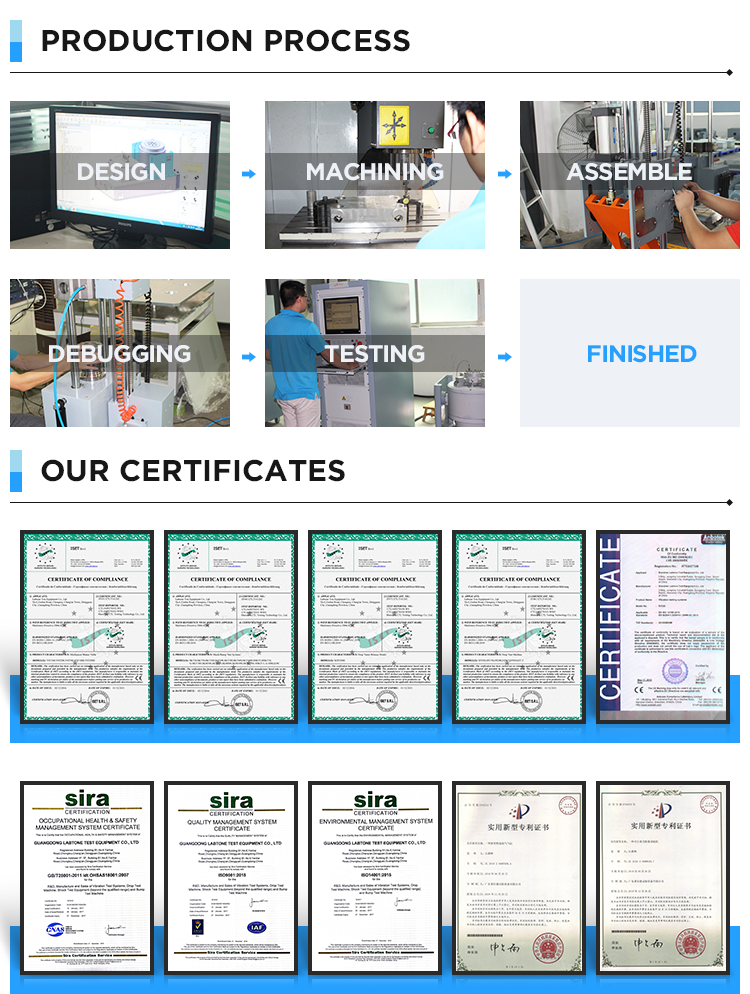

Compact Vibration Shaker System For Laboratory Vibration Testing
Compact Vibration Shaker System For Laboratory Vibration Testing
ET series standard vibration table with light weight, small volume, convenient to move, is widely used in the acceleration sensor calibration, the tiny parts of resistance to vibration test, fatigue test and mechanical impedance test. At the same time, the ET series can also be used for teaching and scientific research and laboratory.
Specifications
| Model | ET50 |
| Rated Sine Exiting Force | 50kg.f(500N) |
| Rated Random Exiting Force | 38kg.f(380N) |
| Frequency Range | 2-3800Hz |
| Max. Acceleration | 37G |
| Max. Amplitude | 10mm |
| Max. Velocity | 1.2m/s |
| Armature Mass | 1.2kg |
| Machine Dimension | DIA 270 * H195mm |
| Cooling Type | Forced cooling |
| Electrical Supply | Power AC220V ±10% 50Hz |
Features
- Apply to high precision vibration meter calibration, mechanical impedance test, vibration analysis of the vibration source
- Apply to various of sensor, electronic, electric machines and other small lightweight vibration test .
- Apply to the basic test of vibration engineering education equipment, etc.
FAQ
How do you attach the hardware you’re testing to your shaker?
By means of a fixture, usually aluminum or magnesium for lightness
coupled with rigidity. They can be cast, or smaller fixtures
machined from solid stock. Most fixtures are welded.
How do you control shakers?
If we’re looking for resonances in the product we’re testing, we
command the shaker to shake the product at one frequency at a time
but to vary that test frequency, to sweep it over a range of
frequencies.But more realistically, we command the shaker to
vibrate randomly and to excite all the resonances
simultaneously.Control commands go into the keyboard of a
specially-programmed computer.
What are those resonances?Are they bad?
Have you ever noticed the steering wheel moving with rather large
displacement amplitude, larger than the input to the column? That
magnification is called resonance. Possibly it annoys you. There’s
a slight chance that in a few years that whipping of the steering
column might cause bending fatigue failure.When we shake an
automotive or ship or land vehicle instrument, we're looking for,
for example, portions of printed wiring boards (PWBs) responding
with greater motion than we're inputting. That flexing may damage
PWB wiring, it may damage the attached components, and it will
damage the soldered connections between components and the PWB.
Service
Pre-Sales Service
1)Technical consultation: test method, laboratory planning and
suggestion.
2)Equipment selection: selection scheme, FAQ.
3)Product testing scheme.
4)Customer communication and progress report.
After-Sales Service
1)Technical training: operation of equipment, daily maintenance,
common fault diagnosis and troubleshooting.
2)Scheduled on-site service: Detection of problem as soon as
possible in order to eliminate equipment and anthropogenic hazards.
This is to ensure long term and stable equipment operation as well
as delivery of latest technical information.
3)Technical support: special paid services are provided according
to customer’s needs.
Product Detail:

Labtone Test Equipment Co., Ltd
Labtone Test Equipment Co., Ltd. is a +20 year China manufacture of reliable, cost-effective equipments . Our superior products mainly include: Vibration Test Systems, Shock Test Systems, Bump Test Machine, Drop Tester, Transportation Simulators, Combined Environmental Test Chambers.
Labtone started business in 2002 in a plant located in Shenzhen and moved to our new, expand 6,000 square meter facility in Donguan, GuangDong in 2015.Today, Our products are found around the world in electronics, automotive,automotive,aerospace,telecommunication, optoeletronics instrument and industrial machinery applications. Our experience, and commitment to new product development, has resulted in products that are easy to use,accurate and designed for decades of service
Labtone products carry a one-year(12months) Warranty and are available direct from our factory in Dongguan, China. We provide comprehensive factory service and support,technical literature, manuals and guides as well as having a qualified staff of experts to help solve your application issues.
We sincerely invite you to visit our factory.




